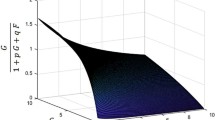Abstract
A mathematical model is formulated to describe the link between obesity and diabetics. The equilibrium points are found and the local stability has been analyzed. The global stability of the illness of obesity and diabetics has been studied. Numerical simulations are carried out through MATLAB to validate the analytical findings.
Access this chapter
Tax calculation will be finalised at checkout
Purchases are for personal use only
Similar content being viewed by others
References
Mechanism linking diabetes mellitus and obesity: Abdullah S Al-Goblan, Mohammed A Al-Alfi and Muhammad Z Khan. Diabetes, Metabolic Syndrome and Obesity: Targets and Therapy 7, 587–591 (2014)
A. Boutayeb, E.H.Twizell, K.Achouayb and A.Chetouani: A mathematical model for the burden of diabetes and its Complications. BioMedical Engineering OnLine, 3(20)(2004) https://doi.org/10.1186/1475-925X-3-20
Enrique Lozano-Ochoa, Jorge Fernando Camacho and Cruz Vargas-De-Leon: Qualitative Stability Analysis of an Obesity Epidemic Model with Social Contagion. Discrete Dynamics in Nature and Society, 2017, Article ID 1084769, 12 pages (2017) https://doi.org/10.1155/2017/1084769
Gilberto Gonzalez,Lucas Jodar, Rafael Villanueva and Fransisco Santonja: Random modeling of population dynamics with uncertainty. Wseas Transactions on Biology and Biomedicine, 5(2), 2008
Jonas Prenissl , Lindsay M. Jaacks, Viswanathan Mohan, Jennifer Manne-Goehler, Justine I. Davies, Ashish Awasthi, Anne Christine Bischops, Rifat Atun, Till Barnighausen, Sebastian Vollmer and Pascal Geldsetzer: Variation in health system performance for managing diabetes among states in India: a cross-sectional study of individuals aged 15 to 49 years. BMC Medicine, 17(92)(2019) https://doi.org/10.1186/s12916-019-1325-6
Kaveeshwar, S.A., Cornwall, J.: The current state of diabetes mellitus in India. AMJ 7(1), 45–48 (2014). https://doi.org/10.4066/AMJ.2014.1979
Ejima, Keisuke, Thomas, Diana, Allison, David B.: A Mathematical Model for Predicting Obesity Transmission With Both Genetic and Nongenetic Heredity. HHS Public Access 26(5), 927–933 (2018). https://doi.org/10.1002/oby.22135
Nagarathna, R., Bali, P., Anand, A., Srivastava, V., Patil, S., Sharma, G., Manasa, K., Pannu, V., Singh, A., Nagendra, H.R.: Prevalence of Diabetes and Its Determinants in the Young Adults Indian Population-Call for Yoga Intervention. Front. Endocrinol. 11, 507064 (2020). https://doi.org/10.3389/fendo.2020.507064
Ravi Shanker Dubey and Pranay Goswami: Mathematical model of diabetes and its complication involving fractional operator without singular kernal. Discrete and continuous dynamical systems series 14(7), 2151–2161 (2021). https://doi.org/10.3934/dcdss.2020144
Santonja, F.J., Villanueva, R.J., Jodar, L., Gonzalez-Parra, G.: Mathematical modelling of social obesity epidemic in the region of Valencia, Spain. Mathematical and Computer Modelling of Dynamical Systems 16(1), 23–34 (2010). https://doi.org/10.1080/13873951003590149
Shilpa N. Bhupathiraju and Frank B. Hu: Epidemiology of Obesity and Diabetes and Their Cardiovascular Complications. Circulation Research, 1723–1735, 2016
Wiam Boutayeb, Mohamed E.N. Lamlili, Abdesslam Boutayeb and Mohamed Derouich:The Dynamics of a Population of Healthy People, Pre-diabetics and Diabetics with and without Complications with Optimal Control. Proceedings of the Mediterranean Conference on Information and Communication Technologies, Lecture Notes in Electrical Engineering 380, 463–471(2015) https://doi.org/10.1007/978-3-319-30301-7
nhp.gov.in
Author information
Authors and Affiliations
Corresponding author
Editor information
Editors and Affiliations
Rights and permissions
Copyright information
© 2023 The Author(s), under exclusive license to Springer Nature Singapore Pte Ltd.
About this paper
Cite this paper
Naga Soundarya Lakshmi, V.S.V., Sabarmathi, A. (2023). A Mathematical Analysis on the Obesity and Diabetic Model. In: Sahni, M., Merigó, J.M., Hussain, W., León-Castro, E., Verma, R.K., Sahni, R. (eds) Mathematical Modeling, Computational Intelligence Techniques and Renewable Energy. Advances in Intelligent Systems and Computing, vol 1440. Springer, Singapore. https://doi.org/10.1007/978-981-19-9906-2_20
Download citation
DOI: https://doi.org/10.1007/978-981-19-9906-2_20
Published:
Publisher Name: Springer, Singapore
Print ISBN: 978-981-19-9905-5
Online ISBN: 978-981-19-9906-2
eBook Packages: Intelligent Technologies and RoboticsIntelligent Technologies and Robotics (R0)




